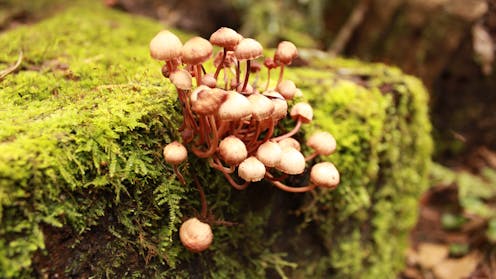It’s wild mushroom season in Australia. Here’s how to stay safe and avoid poisoning
- Written by The Conversation

A number of Australian states including New South Wales, Victoria and South Australia have issued warnings in recent weeks about the risks of eating wild mushrooms.
Mushrooms generally grow in cooler and wetter times. Although these conditions are present in some parts of Australia for much of the year, in many parts of the country, mushroom growth is seen around this time (autumn and early winter).
Wild mushrooms can be easily accessible in public spaces, including parks, nature strips and forests. They’re also found in people’s gardens.
Wild mushrooms attract attention for many reasons, including a new or unexpected location, their interesting colours and shapes, or sometimes because they look similar to edible varieties.
So what do you need to know about the risks of eating wild mushrooms? And what’s the best way to stay safe?
The health risks of eating wild mushrooms
Eating toxic wild mushrooms can have varied effects on people. The reaction can depend on the person, but mostly depends on the type of mushroom.
The most common consequences are gastrointestinal, for example nausea, abdominal pain, vomiting and diarrhoea. Less commonly, people can experience sleepiness, confusion or vision changes including hallucinations.
Fortunately, most people experiencing these reactions will fully recover as their body eliminates the toxins.
But some people suffer severe poisoning requiring admission to hospital. And eating certain high-risk mushrooms can result in permanent damage to vital organs such as the liver or kidneys, or even death.
These effects have occurred from eating wild mushrooms in Australia, and consuming even a single death cap mushroom (Amanita phalloides) can be fatal.
Amanita phalloides has increasingly been detected in Victoria and the Australian Capital Territory in recent years. It’s also known to exist in Tasmania and SA, and has recently been found in NSW.
It’s possible death cap mushrooms are found elsewhere in Australia, but we just haven’t seen them yet.
Incidents are increasing
Recent alerts from NSW and SA show the annual number of calls to poisons information centres about mushroom poisoning is increasing.
In NSW for example, the Poisons Information Centre responded to 363 calls in 2024 regarding exposures to wild mushrooms in NSW and the ACT, an increase of 26% compared to 2023.
What’s more, a higher proportion of cases are requiring referral to hospital.
Roughly half of calls to poisons information centres relate to exposures among young children under the age of five. While most children didn’t have any symptoms, this volume of calls pertaining to young kids is still worrying. A number of these children required assessment and monitoring in hospital.
Many calls to poisons information centres also involve adolescents and adults who forage and eat wild mushrooms. Some consume mushrooms as a food, while others seek their hallucinogenic effects. This group is usually symptomatic when the poisons information centre is contacted, and many require treatment in hospital.
Adults tend to have more severe symptoms because they consume more than children. Most adults who contact poisons information centres with symptoms have eaten wild mushrooms that were foraged outside of a guided tour with an expert.
Not all cases of mushroom poisoning are notified to a poisons information centre, so it’s very likely these case counts represent a significant underestimation of the actual number of exposures and poisonings.
All this suggests we may need more public health messaging around the dangers of wild mushrooms.
Some tips for avoiding poisoning
There’s no easy way to know if a wild mushroom is edible or poisonous, so we advise people against foraging for, and eating, wild mushrooms.
Outside perhaps of an organised tour with an expert, the only mushrooms people should eat are those purchased from a reputable supermarket, grocer or market.
Wild mushrooms can pop up in your garden overnight and toddlers learn about their environment by touching and putting things in their mouths. So it’s worth pre-emptively removing any wild mushrooms from areas where young children play. Wear gloves and discard mushrooms in rubbish bins for landfill.
Some websites, such as iNaturalist, allow people to upload pictures of wild mushrooms so experts may be able to help identify them. However, the quality of the photos can affect an expert’s ability to identify the mushroom species correctly.
If you’re going to use a platform like this, consider taking pictures from multiple angles, showing the top of the cap, under the cap, the stem, the size of the mushroom and the trees that it was found close to.
Research has suggested certain apps may not be reliable on their own for identifying mushrooms.
If you decide to eat wild mushrooms, as well as taking lots of photos, keep samples. In the event you or someone else gets sick, it may be possible for a mycologist (mushroom expert) to identify the mushroom consumed. Knowing the mushroom species can help determine which treatments are required, if any.
Finally, note it’s not possible to detoxify mushrooms. Washing, peeling, cooking or drying a mushroom does not deactivate or remove the toxins.
Who to call if you’re worried
If you or someone you know develops any symptoms from eating a wild mushroom, immediately contact the Poisons Information Centre on 13 11 26 for advice. This is a national phone number that will direct you to the nearest poisons information centre, 24 hours a day.
Even if a child or someone else has no symptoms after eating a potentially poisonous mushroom, call before symptoms develop. Symptoms can take many hours to present with Amanita phalloides, so being asymptomatic is not necessarily reassuring.
In a medical emergency, for example seizures, collapse or unconsciousness, call 000.







